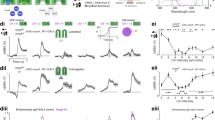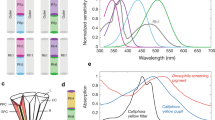Abstract
The eyes of the Japanese yellow swallowtail butterfly, Papilio xuthus, contain six spectral classes of photoreceptors, each sensitive either in the ultraviolet, violet, blue, green, red or broadband wavelength regions. The green-sensitive receptors can be divided into two subtypes, distal and proximal. Previous behavioral and anatomical studies have indicated that the distal subtype appears to be involved in motion vision, while the proximal subtype is important for color vision. Here, we studied the dynamic properties of Papilio photoreceptors using light stimulation with randomly modulated intensity and light pulses. Frequency response (gain) of all photoreceptor classes shared a general profile—a broad peak around 10 Hz with a declining slope towards higher frequency range. At 100 Hz, the mean relative gain of the distal green receptors was significantly larger than any other receptor classes, indicating that they are the fastest. Photoreceptor activities under dim light were higher in the ultraviolet and violet receptors, suggesting higher transduction sensitivities. Responses to pulse stimuli also distinguished the green receptors from others by their shorter response latencies. We thus concluded that the distal green receptors carry high frequency information in the visual system of Papilio xuthus.




Similar content being viewed by others
Notes
Note that the abbreviation, dist-G, contains both ‘double-peaked green (dG)’ and ‘single-peaked green (sG)’ spectral classes in the distal tier in our previous publications (Arikawa et al. 1999). The B class in the current study contains both narrow-B and broad-B receptor subclasses described in Kinoshita et al. (2006).
Abbreviations
- B:
-
blue
- BB:
-
broadband
- G:
-
green
- dist-G:
-
distal green
- prox-G:
-
proximal green
- LED:
-
light-emitting diode
- R:
-
red
- UV:
-
ultraviolet
- V:
-
violet
References
Anderson J, Hardie RC (1996) Different photoreceptors within the same retina express unique combinations of potassium channels. J Comp Physiol A 178:513–522
Anderson JC, Laughlin SB (2000) Photoreceptor performance and the co-ordination of achromatic and chromatic inputs in the fly visual system. Vision Res 40:13–31
Arikawa K (2003) Spectral organization of the eye of a butterfly, Papilio. J Comp Physiol A 189:791–800
Arikawa K, Inokuma K, Eguchi E (1987) Pentachromatic visual system in a butterfly. Naturwissenschaften 74:297–298
Arikawa K, Mizuno S, Scholten DG, Kinoshita M, Seki T, Kitamoto J, Stavenga DG (1999) An ultraviolet absorbing pigment causes a narrow-band violet receptor and a single-peaked green receptor in the eye of the butterfly Papilio. Vision Res 39:1–8
Arikawa K, Mizuno S, Kinoshita M, Stavenga DG (2003) Coexpression of two visual pigments in a photoreceptor causes an abnormally broad spectral sensitivity in the eye of a butterfly, Papilio xuthus. J Neurosci 23:4527–4532
Bendat JS, Piersol AG (1971) Random data: analysis and measurement procedures. John Wiley and Sons Inc, New York
Dyer AG, Arikawa K (2014) A hundred years of color studies in insects: with thanks to Karl von Frisch and the workers he inspired. J Comp Physiol A 200:409–410
Friedrich M, Wood EJ, Wu M (2011) Developmental evolution of the insect retina: insights from standardized numbering of homologous photoreceptors. J Exp Zool B 316:484–499
Frolov R, Immonen EV, Vähäsöyrinki M, Weckström M (2012) Postembryonic developmental changes in photoreceptors of the stick insect Carausius morosus enhance the shift to an adult nocturnal life-style. J Neurosci 32:16821–16831
Hardie RC (1985) Functional organization of the fly retina. In: Ottoson D (ed) Progress in Sensory Physiology, vol 5. Springer, Berlin Heidelberg New York Toronto, pp 1–79
He S, MacLeod DI (1997) Local nonlinearity in S-cones and their estimated light-collecting apertures. Vision Res 38:1001–1006
Heimonen K, Immonen EV, Frolov RV, Salmela I, Juusola M, Vähäsöyrinki M, Weckström M (2012) Signal coding in cockroach photoreceptors is tuned to dim environments. J Neurophysiol 108:2641–2652
Heisenberg M, Buchner E (1977) The role of retinula cell types in visual behavior of Drosophila melanogaster. J Comp Physiol A 117:127–162
Hodgkin A, Rushton W (1946) The electrical constants of a crustacean nerve fibre. Proc Roy Soc B 133:444–479
Horridge GA, Marčelja L, Jahnke R, Matič T (1983) Single electrode studies on the retina of the butterfly Papilio. J Comp Physiol A 150:271–294
Horridge GA, Marčelja L, Jahnke R (1984) Color vision in butterflies 1. Single colour experiments. J Comp Physiol A 155:529–542
Juusola M, de Polavieja GG (2003) The rate of information transfer of naturalistic stimulation by graded potentials. J Gen Physiol 122:191–206
Juusola M, Kouvalainen E, Järvilehto M, Weckström M (1994) Contrast gain, signal-to-noise ratio, and linearity in light-adapted blowfly photoreceptors. J Gen Physiol 104:593–621
Kaiser W (1975) The relationship between visual movement detection and colour vision in insects. In: Horridge GA (ed) The compound eye and vision in insects. Clarendon Press, Oxford, pp 359–377
Kaiser PK, Boynton RM (ed) (1995) Human colour vision, 2nd edn. In. Optical Society of America, Washington DC, p 652
Kinoshita M, Arikawa K (2014) Color and polarization vision in foraging Papilio. J Comp Physiol A 200:513–526
Kinoshita M, Kurihara D, Tsutaya A, Arikawa K (2006) Blue and double-peaked green receptors depend on ommatidial type in the eye of the Japanese yellow swallowtail Papilio xuthus. Zool Sci 23:199–204
Koch C (1998) Biophysics of computation: information processing in single neurons. Oxford University Press, Oxford, New York etc
Koshitaka H, Kinoshita M, Vorobyev M, Arikawa K (2008) Tetrachromacy in a butterfly that has eight varieties of spectral receptors. Proc Roy Soc B 275:947–954
Kv Frisch (1914) Der Farbensinn und Formensinn der Biene. Zool Jb Physiol 37:1–238
Land MF (1999) Motion and vision: why animals move their eyes. J Comp Physiol A 185:341–352
Laughlin S, Weckström M (1993) Fast and slow photoreceptors—a comparative study of the functional diversity of coding and conductances in the Diptera. J Comp Physiol A 172:593–609
Laughlin SB, van Steveninck RRD, Anderson JC (1998) The metabolic cost of neural information. Nat Neurosci 1:36–41
Lehrer M, Wehner R, Srinivasan M (1985) Visual scanning behavior in honeybees. J Comp Physiol A 157:405–415
Lehrer M, Wehner R, Srinivasan M (1989) How honeybees measure their distance from objects of unknown size. J Comp Physiol A 165:605–613
Livingstone M, Hubel D (1988) Segregation from color, movement, and depth—anatomy, physiology, and perception. Science 240:740–749
Marmarelis PZ, Marmarelis VZ (1978) Analysis of physiological systems : the white-noise approach. Plenum Press, New York
Schnaitmann C, Garbers C, Wachtler T, Tanimoto H (2013) Color discrimination with broadband photoreceptors. Curr Biol 23:2375–2382
Skorupski P, Chittka L (2010) Differences in photoreceptor processing speed for chromatic and achromatic vision in the bumblebee, Bombus terrestris. J Neurosci 30:3896–3903
Skorupski P, Chittka L (2011) Photoreceptor processing speed and input resistance changes during light adaptation correlate with spectral class in the bumblebee, Bombus impatiens. PLoS One 6:e25989
Song Z, Postma M, Billings SA, Coca D, Hardie RC, Juusola M (2012) Stochastic, adaptive sampling of information by microvilli in fly photoreceptors. Curr Biol 22:1371–1380
Srinivasan MV, Lehrer M (1984) Temporal acuity of honeybee vision: behavioural studies using moving stimuli. J Comp Physiol A 155:297–312
Strausfeld NJ, Lee J-K (1991) Neuronal basis for parallel visual processing in the fly. Vis Neurosci 7:13–33
Takemura SY, Arikawa K (2006) Ommatidial type-specific interphotoreceptor connections in the lamina of the swallowtail butterfly, Papilio xuthus. J Comp Neurol 494:663–672
Takemura S, Kinoshita M, Arikawa K (2005) Photoreceptor projection reveals heterogeneity of lamina cartridges in the visual system of the Japanese yellow swallowtail butterfly, Papilio xuthus. J Comp Neurol 483:341–350
Vähäkainu A, Vähäsöyrinki M, Weckström M (2013) Membrane filtering properties of the bumblebee (Bombus terrestris) photoreceptors across three spectral classes. J Comp Physiol A 199:629–639
Van Hateren J, Laughlin S (1990) Membrane parameters, signal transmission, and the design of a graded potential neuron. J Comp Physiol A 166:437–448
Wakakuwa M, Kurasawa M, Giurfa M, Arikawa K (2005) Spectral heterogeneity of honeybee ommatidia. Naturwissenschaften 92:464–467
Wakakuwa M, Stavenga DG, Arikawa K (2007) Spectral organization of ommatidia in flower-visiting insects. Photochem Photobiol 83:27–34
Wardill TJ, List O, Li X, Dongre S, McCulloch M, Ting CY, O’Kane CJ, Tang S, Lee CH, Hardie RC, Juusola M (2012) Multiple spectral inputs improve motion discrimination in the Drosophila visual system. Science 336:925–931
Weckström M, Laughlin SB (1995) Visual ecology and voltage-gated ion channels in insect photoreceptors. Trends Neurosci 18:17–21
Yamaguchi S, Wolf R, Desplan C, Heisenberg M (2008) Motion vision is independent of color in Drosophila. Proc Natl Acad Sci USA 105:4910–4915
Acknowledgments
This work was supported by the SOKENDAI visiting professorship to MKa, the JSPS (Japanese Society for Promotion of Science) Grants-in-Aid for Scientific Research C to MKi (24570084) and A to KA (26251036), JSPS open partnership joint research project (Finland) to KA, the NARO (National Agriculture and Food Research Organization) grant for SIP (Strategic Innovation Promotion) Program “Technologies for creating next-generation agriculture, forestry and fisheries” to KA, and the research grant from the Academy of Finland (269332) to MW.
Author information
Authors and Affiliations
Corresponding author
Rights and permissions
About this article
Cite this article
Kawasaki, M., Kinoshita, M., Weckström, M. et al. Difference in dynamic properties of photoreceptors in a butterfly, Papilio xuthus: possible segregation of motion and color processing. J Comp Physiol A 201, 1115–1123 (2015). https://doi.org/10.1007/s00359-015-1039-y
Received:
Revised:
Accepted:
Published:
Issue Date:
DOI: https://doi.org/10.1007/s00359-015-1039-y




